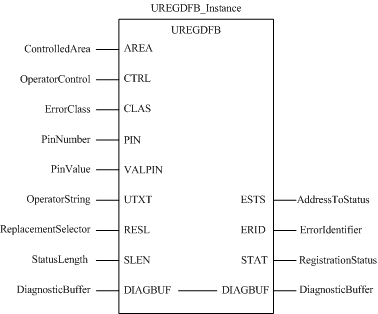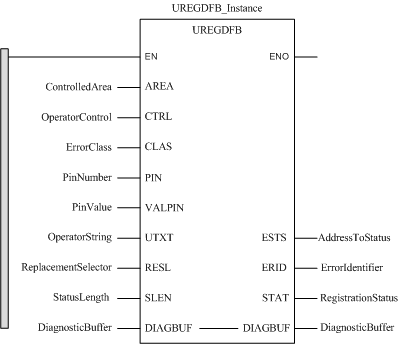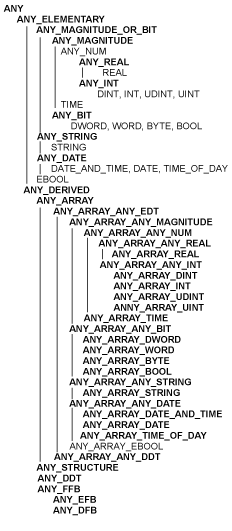|
Description
|
|
|
(Original Document)
|


LD ControlledArea
UREGDFB ErrorClass, StatusLenght, OperatorControl, OperatorString,
ReplacementSelector, PinNumber, PinValue,
AddressToStatus, ErrorIdentifier,
RegistrationStatus
UREGDFB (ontrolledArea, ErrorClass, StatusLenght,
ControlSwitch, UserText, ReplacementSelector,
PinNumber, PinValue, AddressToStatus,
ErrorIdentifier, RegistrationStatus);
|
Parameter
|
Data type
|
Description
|
|---|---|---|
|
AREA
|
Machine area that will be monitored by the diagnostics EFB: 0 to 15
|
|
|
CLAS
|
INT
|
Error type: 16#004A
|
|
SLEN
|
INT
|
Status length: 0, 2 or 4 bytes:
|
|
CTRL
|
|
|
|
UTEXT
|
User-defined error description (only active for RSEL = 1-4)
|
|
|
RSEL
|
INT
|
Replaced by UTEXT
Possible values:
|
|
PIN
|
INT
|
Number of monitored input
|
|
VALPIN
|
BOOL
|
the value expected at the monitored output
|
|
Parameter
|
Data type
|
Description
|
|---|---|---|
|
ESTS
|
Diagnosis DFB status (declared in parameter OUT to be passed on to address and not value). Before this procedure is called it must be updated by the diagnosis DFB .
|
|
|
ERID
|
Error recognition used by the function DEREG to de-register active errors.
Note: The connection to other active errors is lost if the same error recognition variable is used for different errors.
|
|
|
STAT
|
INT
|
RegistrationStatus
|
|
Parameter
|
Type
|
Comment
|
|---|---|---|
|
DIAGBUF
|
Diagnostic buffer that contains the registration result
|

|
Base
|
Lower limit
|
Upper limit
|
|---|---|---|
|
Hexadecimal
|
16#0
|
16#FFFFFFFF
|
|
Octal
|
8#0
|
8#37777777777
|
|
Binary
|
2#0
|
2#11111111111111111111111111111111
|
|
Data
|
Representation in one of the bases
|
|---|---|
|
00000000000010101101110011011110
|
16#ADCDE
|
|
00000000000000010000000000000000
|
8#200000
|
|
00000000000010101011110011011110
|
2#10101011110011011110
|